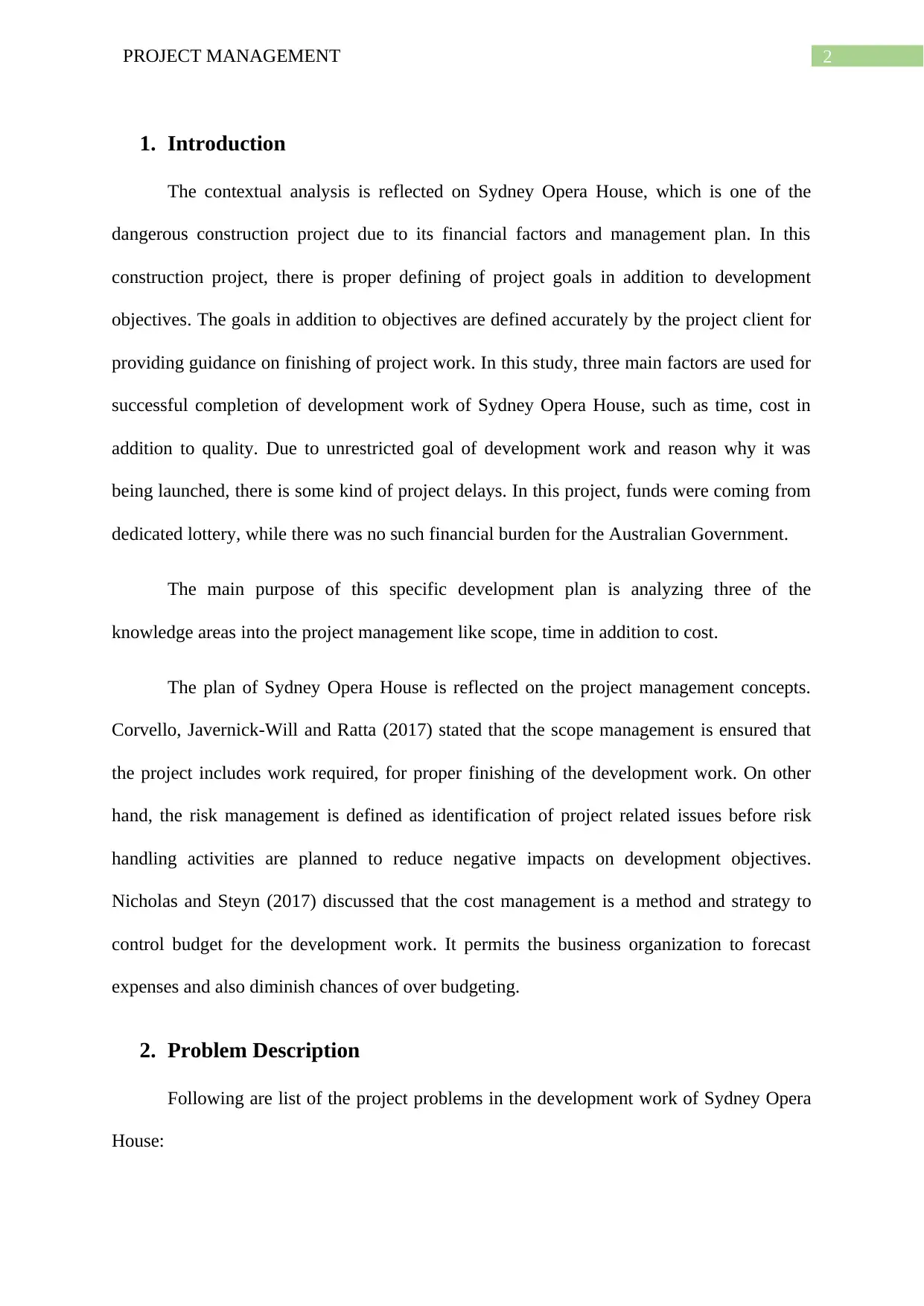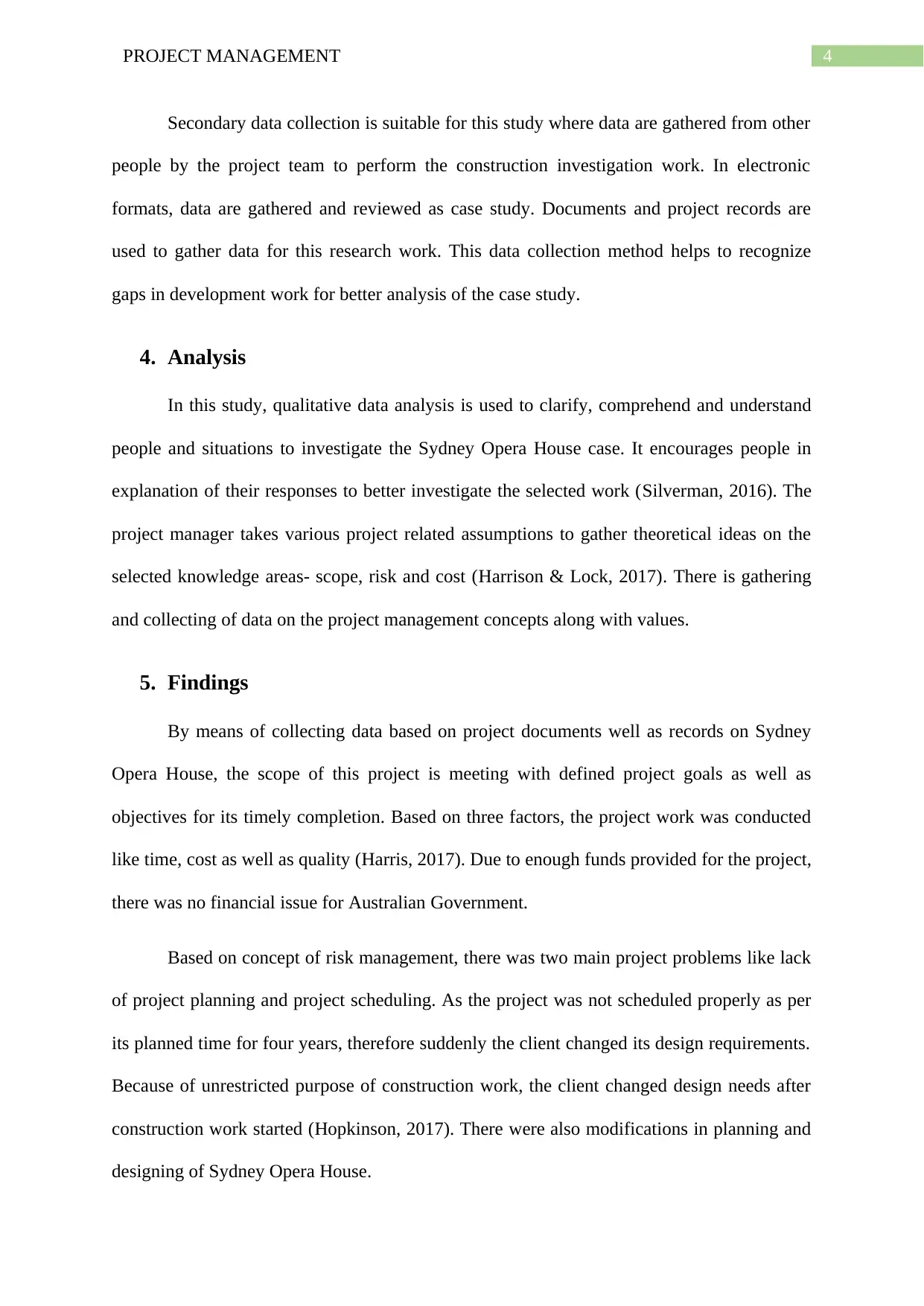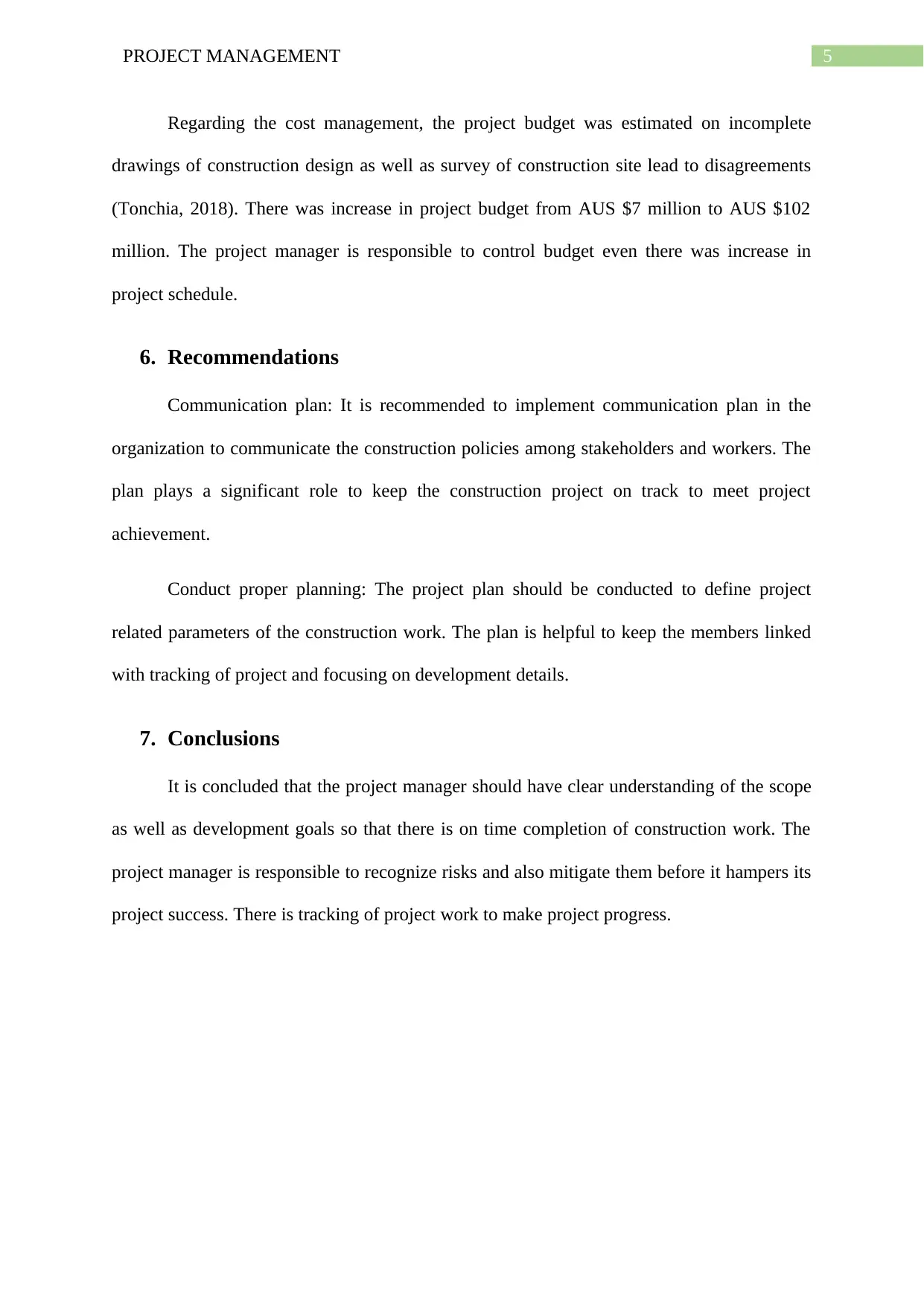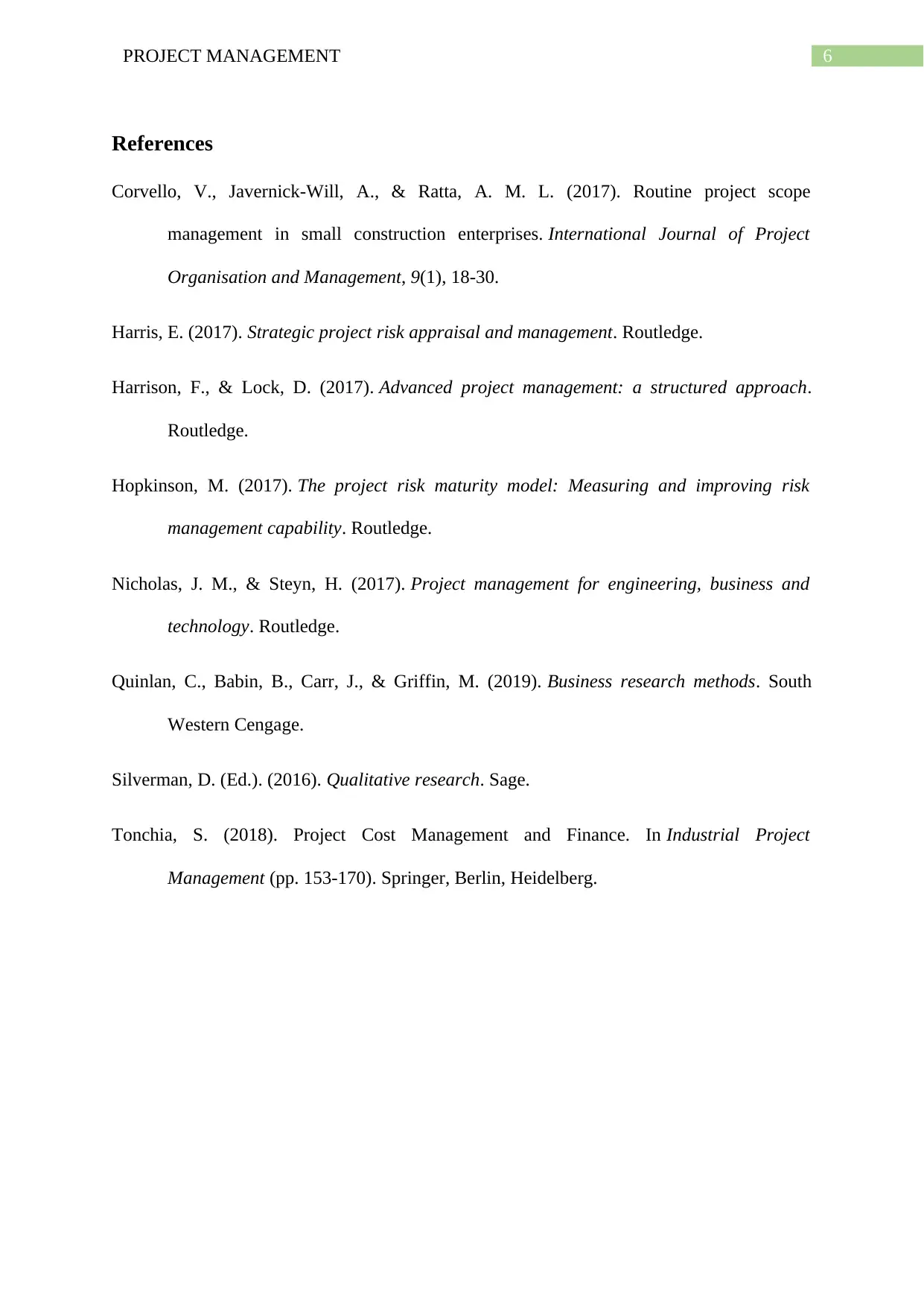Case Study Analysis: Project Management of the Sydney Opera House
VerifiedAdded on 2022/08/25
|7
|1415
|20
Report
AI Summary
This report presents a comprehensive case study analysis of the Sydney Opera House project, focusing on key project management areas. It begins with an introduction and problem description, highlighting the challenges encountered during the construction of this iconic building, including design changes, budget overruns, and schedule delays. The research methodology involves descriptive research and secondary data collection from various sources. The analysis utilizes qualitative data analysis to understand the project's complexities, particularly in scope, risk, and cost management. Findings reveal issues in project planning, design modifications, and budget estimation. The report recommends implementing communication plans and conducting proper planning to mitigate risks and ensure project success. The conclusion emphasizes the importance of clear scope understanding, risk mitigation, and project tracking. References to relevant literature support the analysis, offering a detailed examination of the project's successes and failures within the context of project management principles.

Running head: PROJECT MANAGEMENT
Case Study 2: Sydney Opera House
Name of the Student:
Name of the University:
Case Study 2: Sydney Opera House
Name of the Student:
Name of the University:
Paraphrase This Document
Need a fresh take? Get an instant paraphrase of this document with our AI Paraphraser

1PROJECT MANAGEMENT
Table of Contents
1. Introduction.........................................................................................................................2
2. Problem Description...........................................................................................................2
3. Research Methodology and Data Collection......................................................................3
4. Analysis..............................................................................................................................4
5. Findings..............................................................................................................................4
6. Recommendations...............................................................................................................5
7. Conclusions.........................................................................................................................5
References..................................................................................................................................6
Table of Contents
1. Introduction.........................................................................................................................2
2. Problem Description...........................................................................................................2
3. Research Methodology and Data Collection......................................................................3
4. Analysis..............................................................................................................................4
5. Findings..............................................................................................................................4
6. Recommendations...............................................................................................................5
7. Conclusions.........................................................................................................................5
References..................................................................................................................................6

2PROJECT MANAGEMENT
1. Introduction
The contextual analysis is reflected on Sydney Opera House, which is one of the
dangerous construction project due to its financial factors and management plan. In this
construction project, there is proper defining of project goals in addition to development
objectives. The goals in addition to objectives are defined accurately by the project client for
providing guidance on finishing of project work. In this study, three main factors are used for
successful completion of development work of Sydney Opera House, such as time, cost in
addition to quality. Due to unrestricted goal of development work and reason why it was
being launched, there is some kind of project delays. In this project, funds were coming from
dedicated lottery, while there was no such financial burden for the Australian Government.
The main purpose of this specific development plan is analyzing three of the
knowledge areas into the project management like scope, time in addition to cost.
The plan of Sydney Opera House is reflected on the project management concepts.
Corvello, Javernick-Will and Ratta (2017) stated that the scope management is ensured that
the project includes work required, for proper finishing of the development work. On other
hand, the risk management is defined as identification of project related issues before risk
handling activities are planned to reduce negative impacts on development objectives.
Nicholas and Steyn (2017) discussed that the cost management is a method and strategy to
control budget for the development work. It permits the business organization to forecast
expenses and also diminish chances of over budgeting.
2. Problem Description
Following are list of the project problems in the development work of Sydney Opera
House:
1. Introduction
The contextual analysis is reflected on Sydney Opera House, which is one of the
dangerous construction project due to its financial factors and management plan. In this
construction project, there is proper defining of project goals in addition to development
objectives. The goals in addition to objectives are defined accurately by the project client for
providing guidance on finishing of project work. In this study, three main factors are used for
successful completion of development work of Sydney Opera House, such as time, cost in
addition to quality. Due to unrestricted goal of development work and reason why it was
being launched, there is some kind of project delays. In this project, funds were coming from
dedicated lottery, while there was no such financial burden for the Australian Government.
The main purpose of this specific development plan is analyzing three of the
knowledge areas into the project management like scope, time in addition to cost.
The plan of Sydney Opera House is reflected on the project management concepts.
Corvello, Javernick-Will and Ratta (2017) stated that the scope management is ensured that
the project includes work required, for proper finishing of the development work. On other
hand, the risk management is defined as identification of project related issues before risk
handling activities are planned to reduce negative impacts on development objectives.
Nicholas and Steyn (2017) discussed that the cost management is a method and strategy to
control budget for the development work. It permits the business organization to forecast
expenses and also diminish chances of over budgeting.
2. Problem Description
Following are list of the project problems in the development work of Sydney Opera
House:
⊘ This is a preview!⊘
Do you want full access?
Subscribe today to unlock all pages.

Trusted by 1+ million students worldwide

3PROJECT MANAGEMENT
i. Utzon said that they had not finished designs for the structure of Sydney Opera
House, while the Australian government has insisted to do the construction work.
ii. Suddenly, there was changed in the requirements of design by the development client
after starting work in the construction. There was changed in moving from 2 theatres
to 4, therefore plan as well as designs are modified at the construction time.
iii. Due to design changes, there was change in the project budget as previously budget
was estimated on incomplete design drawings as well as site surveys. There was
additional increase in cost as AUS $1.2 million in the year 1962, while it completed in
1963 with a total budget of AUS 5.2 million. It was 47 weeks over scheduled planned
for entire work.
iv. In the entire construction work, stage two became controversial construction phase
due to increase in project cost. Due to more payments were delivered and there was
no progress in the construction work, therefore government started to withhold the
payments.
v. Due to lack of project designs, new design was created on current structure of Sydney
Opera House and unforeseen situations were identified. It caused increase in project
time from 4 years to 14 years, with increase in cost estimation as AUS $85 million.
3. Research Methodology and Data Collection
Quinlan et al., (2019) mentioned that the research methodology is involved to assume
the research process to gather as well as assess project related data. After analyzing the case
study of Sydney Opera House, it was identified that descriptive research is best method to
describe behaviour of audiences involved in the construction work. It helps to validate
research objective when it comes to particular people group.
i. Utzon said that they had not finished designs for the structure of Sydney Opera
House, while the Australian government has insisted to do the construction work.
ii. Suddenly, there was changed in the requirements of design by the development client
after starting work in the construction. There was changed in moving from 2 theatres
to 4, therefore plan as well as designs are modified at the construction time.
iii. Due to design changes, there was change in the project budget as previously budget
was estimated on incomplete design drawings as well as site surveys. There was
additional increase in cost as AUS $1.2 million in the year 1962, while it completed in
1963 with a total budget of AUS 5.2 million. It was 47 weeks over scheduled planned
for entire work.
iv. In the entire construction work, stage two became controversial construction phase
due to increase in project cost. Due to more payments were delivered and there was
no progress in the construction work, therefore government started to withhold the
payments.
v. Due to lack of project designs, new design was created on current structure of Sydney
Opera House and unforeseen situations were identified. It caused increase in project
time from 4 years to 14 years, with increase in cost estimation as AUS $85 million.
3. Research Methodology and Data Collection
Quinlan et al., (2019) mentioned that the research methodology is involved to assume
the research process to gather as well as assess project related data. After analyzing the case
study of Sydney Opera House, it was identified that descriptive research is best method to
describe behaviour of audiences involved in the construction work. It helps to validate
research objective when it comes to particular people group.
Paraphrase This Document
Need a fresh take? Get an instant paraphrase of this document with our AI Paraphraser

4PROJECT MANAGEMENT
Secondary data collection is suitable for this study where data are gathered from other
people by the project team to perform the construction investigation work. In electronic
formats, data are gathered and reviewed as case study. Documents and project records are
used to gather data for this research work. This data collection method helps to recognize
gaps in development work for better analysis of the case study.
4. Analysis
In this study, qualitative data analysis is used to clarify, comprehend and understand
people and situations to investigate the Sydney Opera House case. It encourages people in
explanation of their responses to better investigate the selected work (Silverman, 2016). The
project manager takes various project related assumptions to gather theoretical ideas on the
selected knowledge areas- scope, risk and cost (Harrison & Lock, 2017). There is gathering
and collecting of data on the project management concepts along with values.
5. Findings
By means of collecting data based on project documents well as records on Sydney
Opera House, the scope of this project is meeting with defined project goals as well as
objectives for its timely completion. Based on three factors, the project work was conducted
like time, cost as well as quality (Harris, 2017). Due to enough funds provided for the project,
there was no financial issue for Australian Government.
Based on concept of risk management, there was two main project problems like lack
of project planning and project scheduling. As the project was not scheduled properly as per
its planned time for four years, therefore suddenly the client changed its design requirements.
Because of unrestricted purpose of construction work, the client changed design needs after
construction work started (Hopkinson, 2017). There were also modifications in planning and
designing of Sydney Opera House.
Secondary data collection is suitable for this study where data are gathered from other
people by the project team to perform the construction investigation work. In electronic
formats, data are gathered and reviewed as case study. Documents and project records are
used to gather data for this research work. This data collection method helps to recognize
gaps in development work for better analysis of the case study.
4. Analysis
In this study, qualitative data analysis is used to clarify, comprehend and understand
people and situations to investigate the Sydney Opera House case. It encourages people in
explanation of their responses to better investigate the selected work (Silverman, 2016). The
project manager takes various project related assumptions to gather theoretical ideas on the
selected knowledge areas- scope, risk and cost (Harrison & Lock, 2017). There is gathering
and collecting of data on the project management concepts along with values.
5. Findings
By means of collecting data based on project documents well as records on Sydney
Opera House, the scope of this project is meeting with defined project goals as well as
objectives for its timely completion. Based on three factors, the project work was conducted
like time, cost as well as quality (Harris, 2017). Due to enough funds provided for the project,
there was no financial issue for Australian Government.
Based on concept of risk management, there was two main project problems like lack
of project planning and project scheduling. As the project was not scheduled properly as per
its planned time for four years, therefore suddenly the client changed its design requirements.
Because of unrestricted purpose of construction work, the client changed design needs after
construction work started (Hopkinson, 2017). There were also modifications in planning and
designing of Sydney Opera House.

5PROJECT MANAGEMENT
Regarding the cost management, the project budget was estimated on incomplete
drawings of construction design as well as survey of construction site lead to disagreements
(Tonchia, 2018). There was increase in project budget from AUS $7 million to AUS $102
million. The project manager is responsible to control budget even there was increase in
project schedule.
6. Recommendations
Communication plan: It is recommended to implement communication plan in the
organization to communicate the construction policies among stakeholders and workers. The
plan plays a significant role to keep the construction project on track to meet project
achievement.
Conduct proper planning: The project plan should be conducted to define project
related parameters of the construction work. The plan is helpful to keep the members linked
with tracking of project and focusing on development details.
7. Conclusions
It is concluded that the project manager should have clear understanding of the scope
as well as development goals so that there is on time completion of construction work. The
project manager is responsible to recognize risks and also mitigate them before it hampers its
project success. There is tracking of project work to make project progress.
Regarding the cost management, the project budget was estimated on incomplete
drawings of construction design as well as survey of construction site lead to disagreements
(Tonchia, 2018). There was increase in project budget from AUS $7 million to AUS $102
million. The project manager is responsible to control budget even there was increase in
project schedule.
6. Recommendations
Communication plan: It is recommended to implement communication plan in the
organization to communicate the construction policies among stakeholders and workers. The
plan plays a significant role to keep the construction project on track to meet project
achievement.
Conduct proper planning: The project plan should be conducted to define project
related parameters of the construction work. The plan is helpful to keep the members linked
with tracking of project and focusing on development details.
7. Conclusions
It is concluded that the project manager should have clear understanding of the scope
as well as development goals so that there is on time completion of construction work. The
project manager is responsible to recognize risks and also mitigate them before it hampers its
project success. There is tracking of project work to make project progress.
⊘ This is a preview!⊘
Do you want full access?
Subscribe today to unlock all pages.

Trusted by 1+ million students worldwide

6PROJECT MANAGEMENT
References
Corvello, V., Javernick-Will, A., & Ratta, A. M. L. (2017). Routine project scope
management in small construction enterprises. International Journal of Project
Organisation and Management, 9(1), 18-30.
Harris, E. (2017). Strategic project risk appraisal and management. Routledge.
Harrison, F., & Lock, D. (2017). Advanced project management: a structured approach.
Routledge.
Hopkinson, M. (2017). The project risk maturity model: Measuring and improving risk
management capability. Routledge.
Nicholas, J. M., & Steyn, H. (2017). Project management for engineering, business and
technology. Routledge.
Quinlan, C., Babin, B., Carr, J., & Griffin, M. (2019). Business research methods. South
Western Cengage.
Silverman, D. (Ed.). (2016). Qualitative research. Sage.
Tonchia, S. (2018). Project Cost Management and Finance. In Industrial Project
Management (pp. 153-170). Springer, Berlin, Heidelberg.
References
Corvello, V., Javernick-Will, A., & Ratta, A. M. L. (2017). Routine project scope
management in small construction enterprises. International Journal of Project
Organisation and Management, 9(1), 18-30.
Harris, E. (2017). Strategic project risk appraisal and management. Routledge.
Harrison, F., & Lock, D. (2017). Advanced project management: a structured approach.
Routledge.
Hopkinson, M. (2017). The project risk maturity model: Measuring and improving risk
management capability. Routledge.
Nicholas, J. M., & Steyn, H. (2017). Project management for engineering, business and
technology. Routledge.
Quinlan, C., Babin, B., Carr, J., & Griffin, M. (2019). Business research methods. South
Western Cengage.
Silverman, D. (Ed.). (2016). Qualitative research. Sage.
Tonchia, S. (2018). Project Cost Management and Finance. In Industrial Project
Management (pp. 153-170). Springer, Berlin, Heidelberg.
1 out of 7
Related Documents
Your All-in-One AI-Powered Toolkit for Academic Success.
+13062052269
info@desklib.com
Available 24*7 on WhatsApp / Email
![[object Object]](/_next/static/media/star-bottom.7253800d.svg)
Unlock your academic potential
Copyright © 2020–2025 A2Z Services. All Rights Reserved. Developed and managed by ZUCOL.



